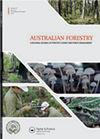Reshaping forest management in Australia to provide nature-based solutions to global challenges
IF 1.2
4区 农林科学
Q3 FORESTRY
引用次数: 6
Abstract
ABSTRACT It is time to move beyond the era of conflict and develop a new shared vision for the management of Australia’s public forests. We need more holistic approaches that encompass all forest values across the landscape, rather than the current approach of dividing public forest management up across different government agencies. More collaborative approaches will be required to galvanise the resources, skills and knowledge that enables this shift in shared governance. Recent bushfires in Australia have heightened concerns that the management of public forest lands has largely failed to ensure the health of forest ecosystems, build resilience, and secure a promised balance between economic, social and environmental values. Investment in efforts to adapt forest management to address climate change has been limited; and empowering and increasing the role of Indigenous Australians in forest management could be significantly improved. Furthermore, the COVID-19 pandemic has highlighted the need to improve the resilience of regional communities to major shocks and stresses caused by factors that encompass market dynamics, supply-chain disruptions and natural disasters. Three key strategies are proposed to strengthen forest management in Australia: first, establishing new shared governance models that bring together government agencies with Indigenous Australians and actors from the private sector and civil society; second, extending active and adaptive management across forest landscapes that builds resilience in our forests, local communities and society; and third, integrating traditional knowledge with scientific evidence and innovative technologies to enhance forest management for improved resilience and other outcomes.重塑澳大利亚森林管理,为应对全球挑战提供基于自然的解决方案
现在是时候走出冲突时代,为澳大利亚公共森林的管理制定一个新的共同愿景了。我们需要更全面的方法,涵盖整个景观中的所有森林价值,而不是目前将公共森林管理划分为不同政府机构的方法。需要更多的合作方法来激发资源、技能和知识,从而实现共享治理的转变。澳大利亚最近发生的山火加剧了人们的担忧,即公共林地的管理在很大程度上未能确保森林生态系统的健康,建立抵御能力,并确保经济、社会和环境价值之间的平衡。对调整森林管理以应对气候变化的努力的投资有限;增强澳大利亚土著人在森林管理中的能力和作用可以得到显著改善。此外,新冠肺炎疫情突出表明,需要提高区域社区对市场动态、供应链中断和自然灾害等因素造成的重大冲击和压力的抵御能力。为加强澳大利亚的森林管理,提出了三项关键战略:第一,建立新的共享治理模式,将政府机构与澳大利亚土著人以及私营部门和民间社会的行动者聚集在一起;第二,在森林景观中扩大积极和适应性的管理,以增强我们的森林、当地社区和社会的复原力;第三,将传统知识与科学证据和创新技术相结合,加强森林管理,以提高复原力和其他成果。
本文章由计算机程序翻译,如有差异,请以英文原文为准。
求助全文
约1分钟内获得全文
求助全文
来源期刊

Australian Forestry
FORESTRY-
CiteScore
3.70
自引率
4.80%
发文量
15
审稿时长
>12 weeks
期刊介绍:
Australian Forestry is published by Taylor & Francis for the Institute of Foresters of Australia (IFA) for scientific, technical, and professional communication relating to forestry in the Asia Pacific.
 求助内容:
求助内容: 应助结果提醒方式:
应助结果提醒方式:


